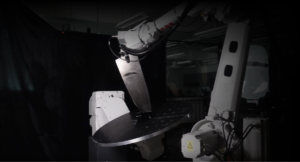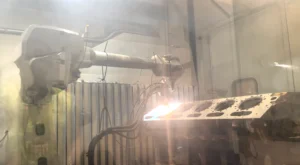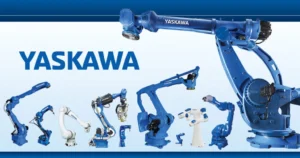table of contents
- Heading 1
- Heading 1
- Heading 1
share this
In 2024, you don’t need to be a coding expert to program robots. Robotics programming for beginners has never been more accessible. This blog aims to explore the challenges of programming industrial robots, how robots are programmed, the methods used to program them, best practices, and other essential topics.
Let’s start with the basics.
What are Industrial Robots?
Industrial robots are automated machines that are involved in a manufacturing or production activity. These machines usually do that with tremendous precision and speed.
There is a sub-category of machines within this segment called the collaborative robots. These robots do the same thing as normal industrial robots. However, collaborative robots, also called cobots, are equipped with additional sensors or protection jackets that stop whenever they touch a human. This safety feature allows robots and humans to perform collaborative tasks together in the same area. For example, a robot can carry a heavy part while workers do the wiring work, which the robot cannot do easily. Cobots are one step ahead because of this collaborative capability.
Also, don’t confuse industrial robots with humanoid robots. They are not the same. Humanoid robots are designed to mimic human movements and interactions. Whereas, industrial robots are mostly 6-axis arm robots with auxiliary/external axes. The external axis here is stationary on a platform.
Why Traditional Industrial Robot Programming Is Difficult
In traditional robot programming, programmers use low-level, manufacturer-specific languages. The instructions given in the program are very specific and detailed.
This approach is called on-line programming and it usually requires the use of a teach pendant. The teach pendant is nothing but a handheld device that guides the robot via every movement, recording particular positions and moves
This process is meticulous and regularly involves manually moving the robotic to each factor in its task sequence. It requires specialized skills. It also becomes complex based on the task performed and the programming language used. All of these make programming the traditional way time-consuming and difficult.
4 Programming Methods for Industrial Robots
So how are robots programmed? Industrial robots are designed using a variety of techniques. Let’s discuss the most common methods out of them.
1. Teach pendant programming
In this method, as discussed, the programmer manually guides the robot through its tasks. The recorded coordinates are used to generate the steps the robot will follow during operation. Teach Pendants are easy to program with their intuitive interface. These are time-consuming and require production to be stopped during programming. But, when done right, these offer incredible precision in the task performed.
2. Text-based programming
Some manufacturers use custom programming languages for their robots. Some of the top robot manufacturers and their programming languages:
These are mostly text-based commands that are fed to the robot and tested side by side.
3. Offline Programming
Offline programming uses simulation software. It allows programmers to program robots and test them on a computer. The movements are then loaded onto the robot for execution. This approach frees up downtime, as design and testing are done without interrupting production. It minimizes changes and modifications in the actual workplace.
4. Lead-through Programming
Very similar to the teach pendant, but instead of a pendant, the programmers guide the robot by moving the arm physically to achieve desired movements. This approach is commonly used for collaborative robots (cobots). It is more intuitive, as it requires direct manipulation of the robot. Lead-through is ideal in projects that require high dexterity or human-like skills. However, it may not be suitable for high-precision tasks and may be limited by the physical capacity of the programmer.
Best Practices for Industrial Robot Programming
How to program robots? Industrial robots must be programmed in a way that does not affect productivity or safety. The following best practices ensure that:
1. Using Reusable Modules
Breaking down programs into reusable modules makes debugging, maintenance, and scaling easier. This approach ensures the updates and modifications don’t affect the entire system.
2. Program Standardization
Using program standardization helps programming efficiency consistency. Implement uniform IO definitions and documentation for better clarity. Adopting standardized module naming conventions enhances code readability and organization.
3. Leveraging Comments and Version Control
Include comments within the code, and following version control. Follow the standards while doing so. These habits help users better understand code, solve problems, and train new programmers.
4. Constant Learning
Include comments within the code, and following version control. Follow the standards while doing so. These habits help users better understand code, solve problems, and train new programmers.
5. Following Safety Protocols
These include defining safety zones, setting speed limits, and ensuring emergency stop mechanisms are in place. Such strong security measures protect users and devices.
Simplifying Industrial Robot Programming With Augmentus
Augmentus is a revolutionizing no-code design solution for industrial robots. The intuitive drag-and-drop feature makes programming way easier in Augmentus compared to other methods. It does not need extensive programming skills and reduces the learning curve. Both beginners and experts find the platform ideal.
The platform uses AI (artificial intelligence) and 3D scanning to automatically create the optimal robotic path for better accuracy. Augmentus offers powerful simulation tools to test and validate systems in a virtual environment before deploying them to robots. It also allows program robots without the need for extensive training. In the long run, this could save valuable time which can be better spent elsewhere.
Conclusion
Choosing the right program can be the difference between an effective and painful robot programming experience. Therefore, before making a selection, consider the level of expertise, interface methods, task complexity, and compatibility with available resources.
If you are looking for a code-free and AI-powered solution that can meet the needs of top robot brands, then Augmentus is right for you. If you don’t know how to program a robot, how to choose the best programming language, or anything related to robot programming, we are happy to help you. Augmentus makes robotics programming for beginners easy. Speak to an experienced automation expert by booking your demo today.
FAQs
1. What programming language do industrial robots use?
ABB robots use RAPID, FANUC robots use FANUC TP, KUKA robots use KRL, and Universal Robots use URScript.
2. Is it hard to program an industrial robot?
Yes, programming industrial robots is indeed challenging. But, tools like Augmentus that offer no-code platforms with AI assistance are making it easier these days.
3. What are the methods of programming industrial robots?
Basic programming techniques include teaching pendant programming, text-based programming, offline programming, and lead-through programming.



